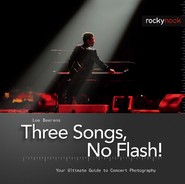The brass section is probably the most beautiful subject photography. With a trumpet player, work so close that every little wrinkle in the face becomes visible. You can read the intensity on a face that's completely deformed by power blown into the instrument. Very your view angle as much as possible in order to get the whole instrument in your picture. As with guitarists, the hands are important. If you can't see them, your shot is no good. The beautiful shape of the trumpet asks for a total shot.
Bill Evans in utmost concentration. The beauty of this photo is the drawing in the blurred background, which adds movement to the total shot. Putting him a bit slantwise in the picture increases the dynamics.
It's not always a disadvantage if the stage is too high. You may shoot less, but I wouldn't have wanted to miss this shot of Randy Brecker.
Standing in front of a white spotlight was the only thing I needed to do to make this perfect shot of David Sanborn. All that was left was to wait for the right expression.
A slide trombone is beautiful from both the front and side, especially when the horn is held next to the face. The slide is pushed forward so far that it becomes out of focus, which gives a great effect of depth. Lou Donaldson's inflated cheeks complete the picture.
The disadvantage of shooting a harmonica player is that he covers up his instrument and his mouth with his hands. To look for another way, as you see here with Toots Thielemans, is the only option. Both pictures were used for his most recent studio album.
Aside from the basic instruments we've already discussed, there are an enormous number of instruments that you will come across every once in a while. It's no use describing them all here. Just try and stick to the rule that you shoot the whole instrument and the way it's played. Instruments like stand-up bass, violin, or samba drum are excellent for dynamic compositions.







